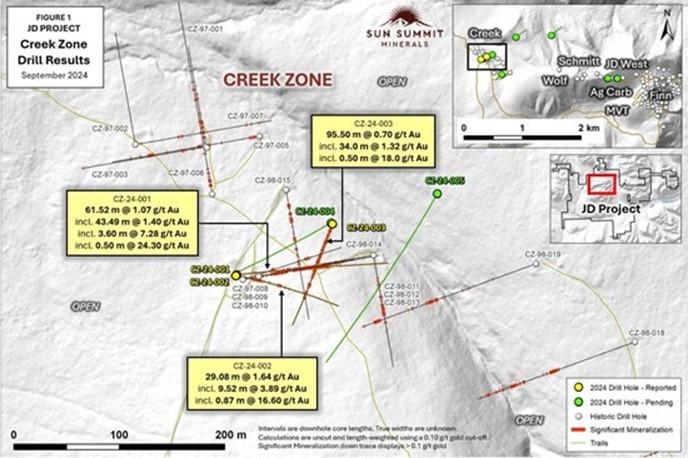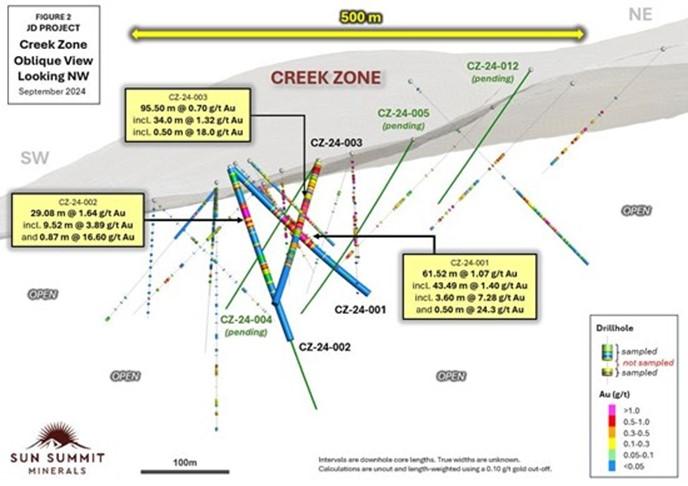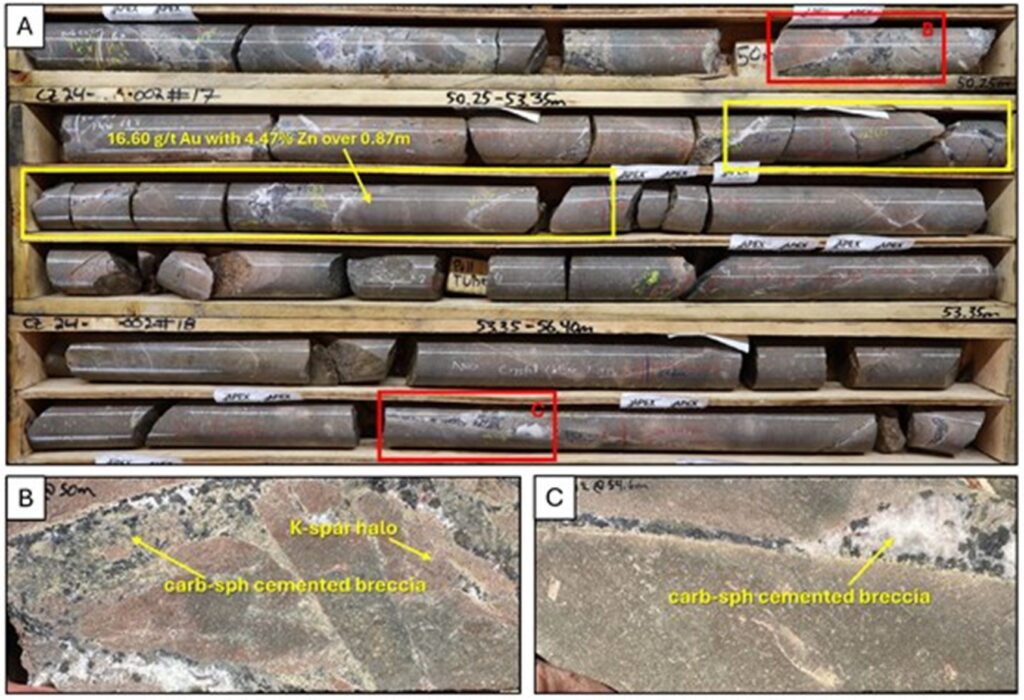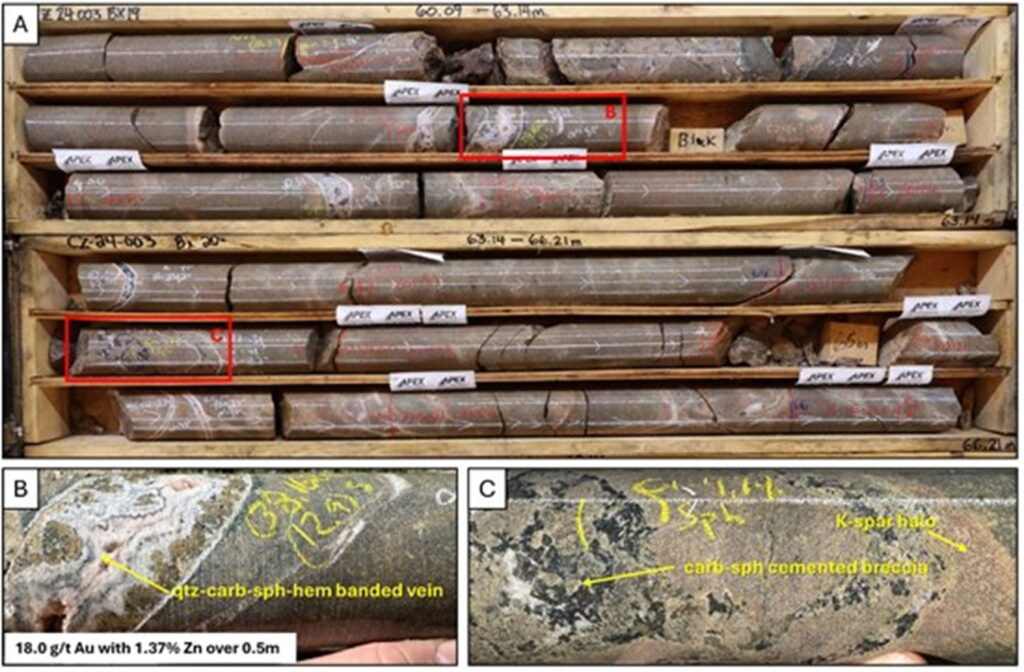
Sun Summit Intersects 43.5 Metres of 1.4 g/t Au Including 3.6 Metres of 7.3 g/t Au in First Hole Drilled at the Creek Zone, JD Project, Toodoggone District, B.C.

Sun Summit Minerals Corp. (TSX-V: SMN) (OTCQB: SMREF) announces initial drill results from its inaugural exploration program at the JD Project in the Toodoggone District, north-central B.C. The first three drill holes at the Creek Zone intersected high grade vein-hosted mineralization found within broad zones of disseminated gold mineralization. Results demonstrate the presence of both high-grade and bulk-tonnage gold mineralization in this under-explored target area of the highly prospective JD Project.
Highlights:
- Intersected multiple zones of high-grade, vein-hosted gold + base metal mineralization within broad zones of bulk-tonnage style gold mineralization:
- 61.52 metres of 1.07 g/t gold, including 43.49 metres of 1.40 g/t gold, 3.60 metres of 7.28 g/t gold, and including 0.50 metres of 24.30 g/t gold, 43.7 g/t silver, and 4.46% zinc (CZ-24-001)
- 29.08 metres of 1.64 g/t gold, including 9.52 metres of 3.89 g/t gold, and including 0.87 metres of 16.60 g/t gold, 11.6 g/t silver, and 4.47% zinc (CZ-24-002)
- 95.50 metres of 0.70 g/t gold, including 34.0 metres of 1.32 g/t gold, and including 0.50 metres of 18.0 g/t gold and 1.37% zinc (CZ-24-003)
- Results demonstrate continuity of strong gold grades and the presence of significant, near-surface disseminated mineralization previously unrecognized due to selective sampling in historical drill programs.
- Additional assay results pending: Assays from the remaining nine drill holes (1,870 metres) are pending, including three additional holes from the Creek Zone.
- Final results pending from numerous project-wide surveys: Results from soil and rock geochemical surveys together with final data products from an Induced Polarization (IP) geophysical survey are pending.
Sharyn Alexander, President of Sun Summit Minerals, stated: “The first three drill holes at the Creek Zone intersected broad zones of continuous near-surface mineralization, which confirm the potential for both high-grade and bulk-tonnage style gold mineralization. These three holes support our initial thesis that selective sampling by previous operators missed the bulk-tonnage gold potential. These findings not only confirm the presence of significant gold mineralization at the Creek Zone but also highlight the untapped potential of this under-explored area. Further drilling is clearly warranted at Creek to fully evaluate the high-grade and bulk-tonnage gold potential. We will release additional results from our summer program as they become available.”

Figure 1. Plan map showing drill collar locations with selected highlights
Drill Program Details
The first three holes of the 2024 exploration program were drilled on the western extent of the 4.5 kilometre-long, target-rich Finn to Creek Corridor. The drill program consisted of 2,537 metres of diamond drilling across 12 holes.
At the Creek Zone, drilling was primarily designed to build on results from past programs where previous drill holes were selectively sampled, vein orientation data was lacking, and disseminated mineralization was not considered. The primary objective of the drilling at the Creek Zone was to; 1) confirm the presence of high-grade gold mineralization, 2) collect systematic downhole data to define a structural model to inform future drill programs and, 3) investigate the presence of disseminated mineralization by continuously sampling from collar to bottom of hole.

Figure 2. Oblique view through Creek Zone drill holes
All three holes intersected a bedded sequence of volcaniclastic and intermediate volcanic rocks interpreted to be a sequence within the McClair Member of the Early Jurassic Toodoggone formation. Higher-grade gold mineralization is hosted in epithermal-related and locally banded quartz-carbonate veins, veinlets and breccias with strong potassium feldspar alteration halos. Vein-hosted sulfides include pyrite, sphalerite, ± chalcopyrite and galena (Figures 3 and 4). Bulk-tonnage mineralization is associated with selectively pervasive epidote-chlorite-pyrite alteration, proximal to vein-associated potassic alteration. The 2024 drill core was oriented and new structural data is being used to build a new targeting model to inform future drill programs.
Table 1. Assay Results 1,2
| Hole ID | From (m) |
To (m) |
Interval (m) |
Au (g/t) |
Ag (g/t) |
Zn (%) |
| CZ-24-01 | 63.0 | 124.5 | 61.52 | 1.07 | 0.8 | 0.09 |
| inc. | 78.0 | 121.5 | 43.49 | 1.40 | 1.1 | 0.12 |
| inc. | 104.0 | 107.6 | 3.60 | 7.28 | 9.4 | 0.98 |
| inc. | 104.0 | 104.5 | 0.50 | 24.30 | 43.7 | 4.46 |
| CZ-24-02 | 41.9 | 71.0 | 29.08 | 1.64 | 1.4 | 0.45 |
| inc. | 48.7 | 58.3 | 9.52 | 3.89 | 3.6 | 1.10 |
| inc. | 51.1 | 52.0 | 0.87 | 16.60 | 11.6 | 4.47 |
| and | 111.0 | 123.0 | 12.00 | 0.33 | 0.2 | 0.01 |
| CZ-24-03 | 4.0 | 138.0 | 134.00 | 0.57 | 0.4 | 0.07 |
| inc. | 4.0 | 99.5 | 95.50 | 0.70 | 0.5 | 0.09 |
| inc. | 58.0 | 92.0 | 34.00 | 1.32 | 1.1 | 0.22 |
| inc. | 58.0 | 66.5 | 8.50 | 2.82 | 1.9 | 0.61 |
| inc. | 61.5 | 62.0 | 0.50 | 18.00 | 2.9 | 1.37 |
| inc. | 84.0 | 92.0 | 8.00 | 1.83 | 2.0 | 0.14 |
- Intervals are downhole core lengths. True widths are unknown.
- Calculations are uncut and length-weighted using a 0.10 g/t gold cut-off.
Holes CZ-24-001 and 002 were collared from the same pad and drilled to the east (Figure 1). Both holes confirm the presence of strong, high-grade gold + base metal mineralization (e.g., 24.30 g/t Au with 4.46 % Zn over 0.5 metres in CZ-24-001 and 16.60 g/t Au with 4.47% Zn over 0.87 metres in CZ-24-002) and extend the zone of high-grade gold mineralization up-dip 50 metres to the south as demonstrated by 29.0 metres of 1.64 g/t Au including 9.52 metres of 3.89 g/t Au in hole CZ-24-002 (Figure 2). Both holes also returned broad zones of >1.0 g/t gold mineralization and support the presence of bulk-tonnage style mineralization cored by higher-grade veins, central to the Creek Zone target area.

Figure 3. Core photos of CZ-24-002; A. Box photos showing core from 49.30m to 56.0m downhole which includes a high-grade interval of 16.60 g/t Au with 4.47% Zn over 0.87m; B. carbonate+sphalerite cemented breccia with strong potassium feldspar alteration halos at 50m downhole; C. carbonate+sphalerite cemented breccia at 54.6m downhole.
Hole CZ-24-003 was collared on the north side of the creek (Figure 1) and drilled to the south at a dip of -55o. A broad interval of continuous mineralization, from top of hole, was intersected highlighted by 95.50 metres of 0.70 g/t Au including 34.0 metres of 1.32 g/t Au. This hole demonstrates the presence of previously unrecognised, near-surface bulk-tonnage style disseminated gold at the Creek Zone. Most historic holes drilled at the Creek Zone in 1997 or 1998 were not completely sampled and therefore failed to recognise the bulk-tonnage potential (Figure 2). Hole CZ-24-003 also intersected vein-hosted, high-grade gold + base metal mineralization highlighted by 18.0 g/t Au with 1.37% Zn over 0.50 metres.

Figure 4. Core photos of CZ-24-003; A. Box photos showing core from 60.1m to 66.2m downhole which includes a high-grade interval (B) of 18.0 g/t Au with 1.37% Zn over 0.5m; B. quartz+carbonate+sphalerite+hematite banded vein at 61.6m downhole; C. carbonate+sphalerite cemented breccia with potassium feldspar halo at 64.2m downhole.
Assays from the remaining drill holes, as well as surface sampling results, are pending and expected to be released as they are received and reviewed.
Table 2. Drill Collar Locations
| Hole ID | Easting | Northing | Elevation (m) | Azimuth | Dip | Depth (m) |
| CZ-24-001 | 608166 | 6368268 | 1500 | 82.4 | -50.9 | 203 |
| CZ-24-002 | 608165 | 6368268 | 1500 | 100.2 | -70.3 | 281 |
| CZ-24-003 | 608257 | 6368317 | 1508 | 199.5 | -55 | 186.2 |
Coordinates are in UTM NAD83 Zone 9N
Quality Assurance and Quality Control
All drill core sample assay and analytical results have been monitored through the Company’s quality assurance and quality control program (QA/QC). Drill core was sawn in half at Sun Summit’s dedicated and secure core logging and processing facility at the Lawyers exploration camp owned by Thesis Gold. Only Sun Summitt and assigned APEX Geoscience field staff were allowed access to the core.
Half of the drill core was sampled and shipped by a bonded courier in sealed and secured woven polyester bags to the ALS Global preparation facilities in Langley, BC and Winnipeg, Manitoba. Core samples were prepared using ALS standard preparation procedure PREP-31A which involves crushing the sample to 70% less than 2mm, followed by a riffle split of 250g, and then a pulverised split to better than 85% passing 75 microns.
Following sample preparation, the pulps were sent to the ALS Global analytical laboratory in North Vancouver, B.C. for analysis. ALS Global is registered to ISO/IEC 17025:2017 accreditations for laboratory procedures.
Drill core samples were analyzed for 48 elements by ICP-MS on a 0.25-gram aliquot using a four-acid digestion (method ME-MS61). This method is considered a “ultra trace element” analytical method with low detection limits on key pathfinder elements such as Ag, As, Sb, Se and Tl.
Gold was analyzed by fire assay on a 30-gram aliquot with an AES finish (inductively coupled plasma atomic emission spectroscopy – method Au-ICP21). Samples that returned >10 parts per million (ppm) gold were re-analyzed by fire assay using a gravimetric finish on a 30-gram aliquot.
Overlimit samples (e.g. Ag, Cu, Pb & Zn) were re-analyzed using an ore-grade, four-acid digestion and ICP-AES finish. Overlimits for key elements: samples with >100 ppm silver, >10,000 Cu, >10,000 Pb and >10,000 Zn. In addition to ALS Global laboratory QA/QC protocols, Sun Summit implements a rigorous internal QA/QC program that includes the insertion of duplicates, certified reference materials (standards prepared by an independent lab) and blanks into the sample stream.
National Instrument 43-101 Disclosure
This news release has been reviewed and approved by Sun Summit’s Vice President Exploration, Ken MacDonald, P. Geo., a “Qualified Person” as defined in National Instrument 43-101 Standards of Disclosure for Mineral Projects of the Canadian Securities Administrators. He has not been able to verify the historical exploration data disclosed, including sampling, analytical and test data, underlying the technical information in this news release since such data is historical and the original drill core is not readily available. Technical information contained in this release is historical in nature and has been compiled from public sources believed to be accurate. The technical information has not been verified by Sun Summit and may in some instances be unverifiable dependent on the existence of historical drill core and grab samples.
Community Engagement
Sun Summit is engaging with First Nations on whose territory our projects are located and is discussing their interests and identifying contract and work opportunities, as well as opportunities to support community initiatives. The Company looks forward to continuing to work with local and regional First Nations with ongoing exploration.
About the JD Project
The JD Project is located in the Toodoggone mining district in north-central British Columbia, a highly prospective deposit-rich mineral trend. The project covers an area of over 15,000 hectares and is in close proximity to active exploration and development projects, such as Thesis Gold’s Lawyers and Ranch projects, TDG Gold’s Baker-Shasta projects, Centerra’s Gold’s Kemess East and Underground projects, as well as the past-producing Kemess open pit copper-gold mine.
The project is 450 kilometres northwest of the city of Prince George, and 25 kilometres north of the Sturdee airstrip. It is proximal to existing infrastructure in place to support the past-producing Kemess mine, including roads and a hydroelectric power line.
The JD Project is in a favourable geological environment characterized by both high-grade epithermal gold and silver mineralization, as well as porphyry-related copper and gold mineralization. Some historical exploration, including drilling, geochemistry and geophysics, has been carried out on the property, however the project area is largely underexplored.
About Sun Summit
Sun Summit Minerals is a mineral exploration company focused on expansion and discovery of district scale gold and copper assets in British Columbia. The Company’s diverse portfolio includes the JD Project in the Toodoggone region of north-central B.C., and the Buck Project in central B.C.
MORE or "UNCATEGORIZED"
Kuya Silver Confirms High-Grade Silver-Gold Vein Mineralization at Umm-Hadid with Initial Drill Results up to 1483.9 g/t AgEq over 2 Metres
Kuya Silver Corporation (CSE: KUYA) (OTCQB: KUYAF) (FSE: 6MR1) is... READ MORE
First Phosphate Closes Final Tranche of Oversubscribed Private Placement
First Phosphate Corp. (CSE: PHOS) (OTCQX: FRSPF) (FSE: KD0) is... READ MORE
GFG Receives Final Payment from the Sale of its Rattlesnake Hills Gold Project
GFG Resources Inc. (TSX-V: GFG) (OTCQB: GFGSF) announces that i... READ MORE
Goliath Receives $1,730,882 Through Warrant Exercises, Inclusive Of Crescat Capital A Longtime Strategic And Cornerstone Shareholder
Goliath Resources Limited (TSX-V: GOT) (OTCQB: GOTRF) (FSE: B4IF)... READ MORE
Robex Pours First Gold at Kiniéro on Schedule and Budget
Highlights: Gold bar weighing 2.64 kilograms (85 oz) poured in th... READ MORE












